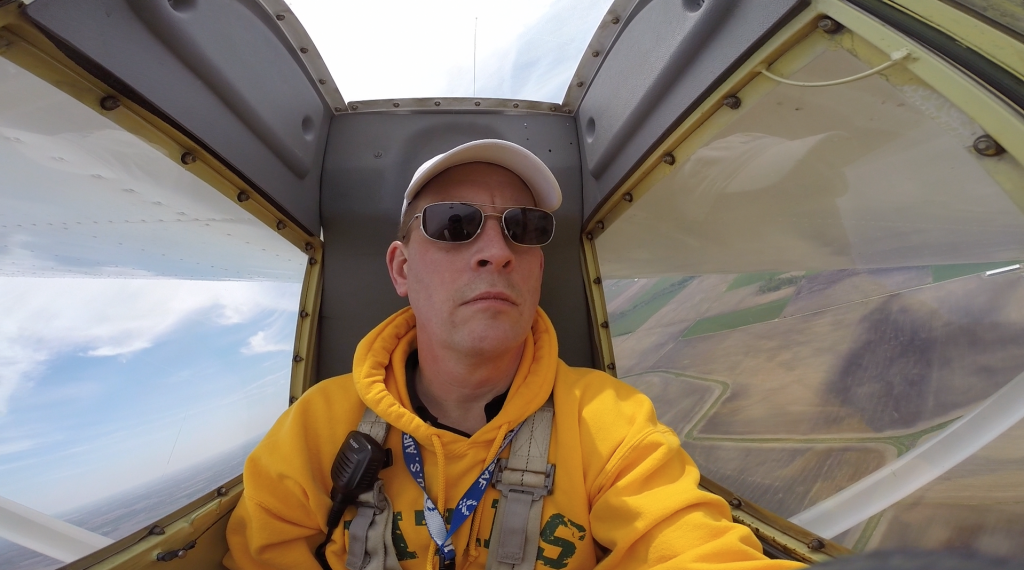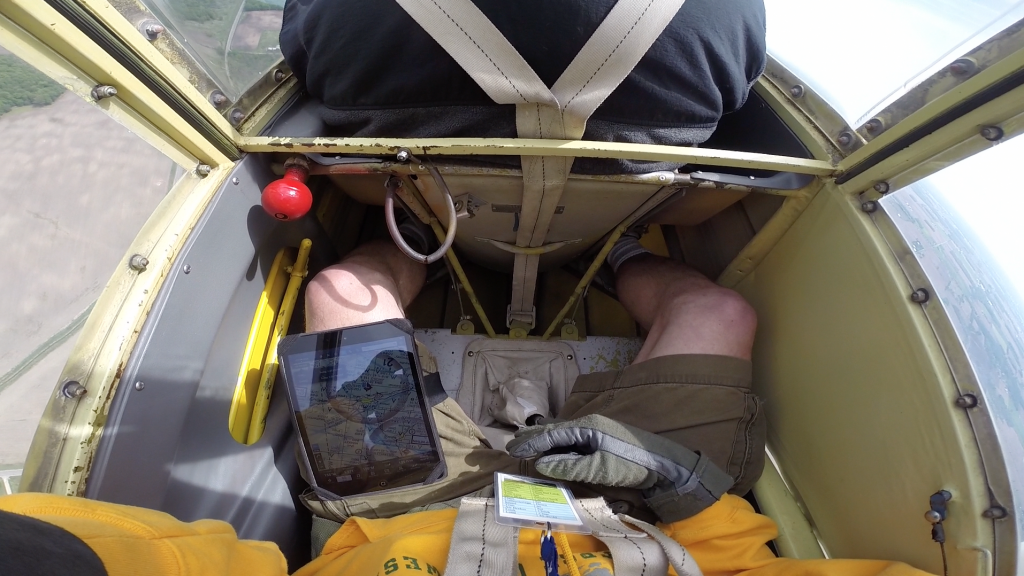I trained again for parts of the last two days at Benz Aviation at Ionia County Airport in Ionia, Michigan. Those just joining this saga will know that last week, after three days of flying in the front seat to get the hang of the Schweizer SGS 2-33A, Lee Larder promoted me to the back seat. We didn’t fly on Wednesday because of the low overcast and we did the knowledge review instead. Thursday was devoted to more flying from the back seat to get the maneuvers nailed down and to build muscle and inertial memory.
The back seat requires some gymnastics for ingress and egress. But, once you’re strapped in, it’s a comfortable place to be. I was slightly worried about the pedals. I have short legs for a guy of my height (28-inch inseam), so I had to adjust the pedals in the front to the full-aft position to get enough purchase on them to be able to box the wake and do slips with authority. The pedals in the back don’t adjust, so I was concerned that I’d have to add some padding behind me. It turns out that the pedals in back are a perfect distance for me. This is a good thing because adding a cushion behind me would likely have made it so that I could not get full-aft stick travel. As it is, I have to sit up straight and get my back flat against the back of the seat in order get enough aft stick to have my stalls break in a concise way.
There’s a little shoving-around over there on the left side if I need to move the stick much to the left while the dive brakes are engaged. Between the stick, the dive brake handle, and my trusty iPad, there’s a jumble of activity when that happens. Conveniently, the iPad simply moves around there on the elastic strap and things tend to work out.
The biggest thing about the back seat is dealing with the lack of visibility. Mostly because of that head and shoulders directly in front of you. You get all of the visibility you need, but not a lot of visibility that isn’t essential. I don’t know that I’d be able to give dual instruction to Bob Ross or Pam Grier. You can fly along with your head centered just fine in most cases. You can listen for your airspeed and, at least in the early parts of the flight, have a pretty good idea that you have enough altitude. If you need airspeed information, you lean right and look (at least when Lee hasn’t covered the airspeed indicator). The picture above gives you that sight picture. If you need altitude information, you lean left. Landing doesn’t seem to be a problem, especially after you quit looking at the airspeed and get into the flare. You just use a lot of peripheral vision. And the Force.
The biggest issue is on tow in the normal high-center tow position. It’s pretty easy to lose the tow plane under the nose. I fly a little lower relative to the tow plane while flying from the back seat to keep it visible. But, in turbulence. the tow plane can drop out of sight very quickly, which means that I’m being more abrupt than I’d like with a push to keep him in the windshield. More than a second or two and I’d need to tug on the clown nose and release, but it hasn’t come close to that.
The only other visibility thing comes with slack-line operations. We go out to the left to climb and then descend to put in the slack. Visibility is fine that way. But it’s sometimes hard to see the amount of slack that you’ve developed because some of it us under the nose. And the slack usually isn’t much. The 2-33A is really draggy and, even with a big push, you don’t get going fast enough relative to the tow plane to put much of a smile into the tow line.
My biggest remaining issue is situational awareness (“SA”) and other larger-picture things. On almost every training day, I make some blunder of thought. Today, I somehow reversed the windstock and briefed a left turn in the case of a rope break. In fact, the wind was from the right. I also let us get low two miles upwind of the airport while preoccupied with maneuvering. We made it back just fine, even if a little low on pattern entry, but I have discovered that finding yourself at 1,400 AGL two miles out and flying in sink is one of my least favorite things in aviation.
Lee commented that I’m doing very well, but he noted that each session has some element of SA fail. I had sure noted this and confessed it each time, and he’s a good IP and noted it, too. But that’s why I’m out here training. I’m gradually becoming a high-time pilot (for recreational GA anyway). I’m pretty darned good at a number of things and I pick up on new things fairly quickly if they’re complementary with skills that I already have. But that can also hide deficiencies that I don’t know that I have. I would imagine that lots of higher-time pilots have this issue. And the mission for which I plan to use my IP skills will skew toward experienced students who will do well enough at some things that there’s a risk of complacency about the needs that are masked by great performance in other respects.
You may recall that I failed my first attempt at the commercial ride because I blew through the stop point on the no-spoiler landing. In training, I did very well on the no-spoilers, mainly because the winds were favorable and I got lucky. Neither John nor I had any reason to think that I didn’t have the maneuver nailed. Then, on the ride, the winds were different and I was not lucky. No big deal. I re-took the deficient parts a couple of weeks later and I’ve flown safely and effectively in gliders for 200 hours since then. But it was a lesson that will color my own training and will affect the way I teach students, especially higher-time people who are transitioning.
It is critical not only that we train, but that we think about that training and make generalizations out of the series of experiences. We spend a lot of time thinking about trees. This is fine, but we need to think about forests, too. Find patterns that tell you things about the way you fly and how to be better every single time.
Sometimes, the only way to find out about these deficiencies is experience. You have to fly more than is strictly necessary. If you’re doing it right, you learn something every time you go to the airport.
Lee asked me on the way back to the terminal whether I wanted him to sign me off for the ride. (Holy crap!) He allowed as how my flying is fine and that I just need to get the SA dialed in. I’m probably under-confident and over-persnickety about the way in which I stand up for a checkride, so I told him that I’d like to fly a few more times before the ride. He agreed. We’re scheduled for next Friday and then Wednesday and Thursday the week after that. Then, probably checkride the first week of June.
Lee’s a good guy. He thinks I’m very nearly ready and he told me that he doesn’t want to take my money unnecessarily. Not every IP would do that. That’s a mark of a guy who really cares about general aviation and instruction.
So the plan is two or three more training days, then the ride. Sounds like this weekend and next will find me in a series of Starbucks with a bin of manuals and ACs next to me. Watch Twitter (@StephenForce) and my Facebook feed and join me if you like. I can even give you loggable ground instruction.




